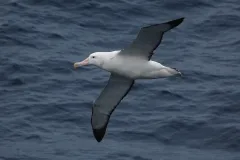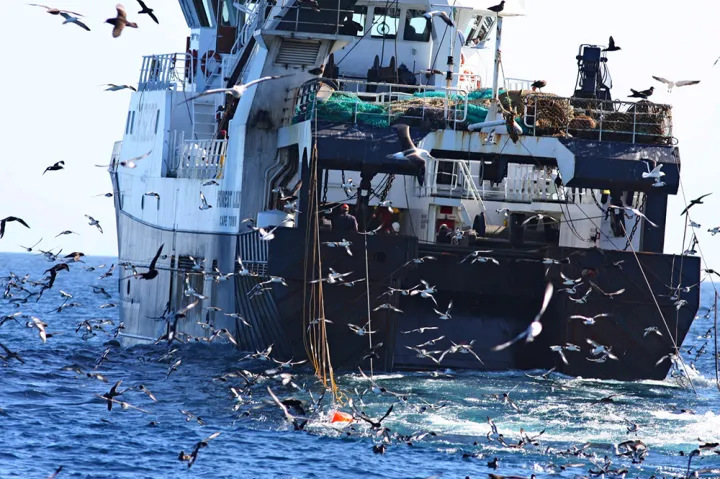Saving Albatross Lives with Bird Scaring Lines

Soaring high above the open Southern Ocean, a snowy, white wandering albatross surveys the expansive waves below. Slicing through the air is barely an effort for the bird whose wings are made for long days at sea and measure an impressive 3.5 meters (11.5 feet) tip to tip, the longest of any bird.
Despite their prowess as seafaring hunters, the wandering albatross is not immune to the lure of an easy snack. What better place to find a squid or hake fish than the back of a fishing boat where the meal is brought up from the sea, almost on a silver platter? Hundreds of birds, including the black-browed albatross, Atlantic yellow-nosed albatross, and the shy-type albatross, will flock to a nearby fishing boat for food—the grinding of the winch motor as it lowers the trawl net is like a dinner bell calling the birds from afar.
What many birds don’t realize is that the easy meal also comes with an extra hazard. On trawl fishing boats, the lines that secure the nets to the end of the boat, called “trawl warps,” are easy to get entangled in, especially considering the long wingspan of the albatross and the competitive frenzy that ensues when fish scraps are tossed overboard. Hitting a wire can break a wing or at least cause the bird to fall into the boat’s strong wake where the undertow from the trawl sucks it underwater. Longlines are also dangerous. A longline fishing boat sets a buoyed string that hovers below the water’s surface and stretches several miles long. At set intervals, thousands of shorter fishing lines with baited hooks drop from the main line, similar to how icicle lights drape from the eaves of houses at Christmas. The bait is an enticing meal for an albatross, which upon eating the squid bait is snagged by the hidden hook and dragged underwater where it often drowns.
A global problem
The death of even a single albatross is cause for concern. Fifteen of the 22 species are threatened with extinction, mostly because of fishing bycatch. The breeding habits of albatross make the bird especially susceptible to extinction, because it takes an albatross about a decade to reach sexual maturity, and then they only raise one chick a year.
The bird bycatch problem first appeared on scientists’ radar in 1972 when C. Eric Tull and his colleagues estimated that roughly 500,000 seabirds called thick-billed murres died annually in the drift gillnets set to capture Atlantic salmon off the coast of Greenland. The estimate was later refined to 207,000 (still an alarming number) but by then scientists were scrutinizing bird bycatch across the globe. A 1991 study specifically looked at albatross deaths and estimated 44,000 individual birds died annually due to longline fishing. Not only were birds dying, but a fisherman’s haul was being reduced when the birds swooped in and stole fish from the hooks or trawls.
Fishermen have tried everything from towing decoy bait to even throwing explosives to keep the birds away. But one of the most effective strategies to deter seabirds from flying near the dangerous gear came from a fisherman in Japan. He found that by flanking the end of his fishing vessel with streamer lines the birds shied away from his wake. Now referred to as bird-scaring lines, the streamers act like a scarecrow—the shimmery and bright streamer fringe waves in the wind and deters the seabirds from coming close to the fishing gear. Initial scientific studies found the bird-scaring lines decreased bird bycatch by 69 percent in the Japanese longline fleet, a significant improvement, but implementing the practice on a global scale has been slow.
The Albatross Task Force
In 2005, the Royal Society for the Protection of Birds and BirdLife International recognized the need for better communication between scientists, governments, and fishermen around the issue of bycatch and so the Albatross Task Force (ATF) was born. The idea was that a group of scientists would work directly with fishermen, both on the docks and on the open sea in order to help them apply practices like using bird-scaring lines.
For South Africa, the timing was perfect—the same year, the South African Deep Sea Trawl Industry Association realized they had a serious problem with accidental bird deaths due to fishing. A 2005 estimate of seabird deaths came to about 18,000 for the 2004 to 2005 fishing season, although newer research indicates the total is probably closer to 9,300 birds. A majority of the bird deaths, approximately 77 percent, were albatross deaths. Something had to change.
“The fishery went through a certification and one aspect that was picked up was that they had no idea what was going on in the bird bycatch realm. That opened the door for us to say, ‘We’re here. We can help you,’” Bronwyn Maree, a previous ATF leader, explained.
It’s one thing to discover the bird-scaring lines work to scare away birds, and quite another to get fishermen to use them. Fishermen are often wary of new bycatch mitigation techniques since they can sometimes affect the number of fish they catch, are cumbersome to use in rough seas, and can be dangerous to deploy.
The first step for the ATF was building a relationship with the fishermen to show them how to use the bird-scaring lines, so starting in 2006 a team of three went to where fishermen feel most at home—right down to the docks.
Andrea Angel is the current Albatross Task Force Leader in South Africa and has spent many hours speaking with fishermen about the importance of bird-scaring lines, not only on the docks but aboard their vessels out at sea. Once they gained the fishermen’s trust, members of the ATF have accompanied trawl fisherman on their vessels to teach them about the birds, how to deploy the lines on their individual boats, and monitor how many birds are dying per vessel.
“The fact that we actually went on board the vessels and we were willing to spend days at sea with them, eating the same food, sleeping on the same bunks, under the same living conditions turned their perception,” says Angel. “We know the difficulties they face, we understand the weather, so we ask ‘How can we actually adapt them [bird-scaring lines] to your vessel specifically or your gear setup?”
The ATF works closely with individual fishermen in the wet-trawl fleet, which stows their catch on ice. The boats are small—a maximum 30 meters long—and can stay out at sea up to 11 days. Space is tight and rough seas can keep the small vessel in a constant pitch and roll. Lunch is fried fish from the day’s catch, boiled veggies and perhaps a crisp apple stowed in a personal backpack. But the close quarters help build camaraderie between the fishermen and task force members.
“We sit on the back of a trawl vessel for hours, and I’m showing them the albatrosses as they come in the hundreds behind the trawl vessel,” says Angel. “They were fascinated by them. We were bringing out our bird books to interact with the crew. That makes a huge impact.”
It’s been just over 10 years since the ATF began accompanying fishermen out to sea, and the program has witnessed remarkable success. Between 2006 and 2014 total bird bycatch in the trawl industry decreased by 90 percent, and for albatross 99 percent. Thirty two of the 52 vessels have an up-to-date protocol for using the bird-scaring lines, and 100 percent of the vessels the ATF worked with this past year used proper mitigation measure.
“The challenge now is to get on the other fleets,” says Angel. “We’re riding on the success we had with the trawl industry and rapport with them and going to the other associations and saying, ‘We can do the same for you.’”
Besides the trawl fleet, South Africa has a hake demersal longline fishery, which sets hooked lines deep near the bottom of the ocean, and the pelagic longline fishery, which targets fish closer to the water’s surface. Both are required to set their lines at night, a time when fewer birds are likely to be feeding. In addition to bird-scaring lines, the ATF is teaching them about lumo leads, or slide leads—an easy-to-use weight system that quickly drags the baited hook underwater out of the reach of hovering birds (otherwise, the lines slowly drift down from just the weight of the hook and bait). There’s even a fancy weight system called a hook pod that initially covers the baited hook; a pressure sensitive release system uncovers the bait at 10 meters. These hook pods negate the need for weights, setting at night, and bird-scaring lines since it keeps the bait out of the birds reach.
“It’s about giving them options. Every vessel is different, there’s different sizes, there’s different speeds they go, they’re out for different lengths of time, so the more options you give them the more likely they are to use one of them,” says Maree.
Community connections
Bird-scaring lines in South Africa do more than just help the birds, they’re also supporting a local community. The lines are assembled in a local coastal town called Ocean View by a group called the Ocean View Association for Persons with Disabilities. The association helps disabled people learn trades and skills that they can then use to make a living.
“This has really changed this little community,” says Angel. “They’ve really changed as human beings because it gives them confidence, they are integrated into society, and they’re earning an income.”
The Albatross Task Force supplies the materials—cable ties, garden hose, rope, and plastic strapping—and the completed lines are then sold to fishing companies for a small profit. The hope is that one day the process will sustain itself and the Ocean View Association will no longer need support from the task force.
A global network
The success of South Africa is now the source of inspiration for many other countries. The Albatross Task Force is active in seven other countries—Argentina, Brazil, Chile, Ecuador, Namibia, Peru and Uruguay—with a sister program called the European Seabird Task Force gaining traction in Lithuania, Poland and Spain. Each country presents unique challenges for the task force since they have their own management system and various types of fisheries to cater to. Namibia, once one of the worst offenders for bird bycatch, is emerging as another global leader in reducing bird deaths.
For Angel, much of the reward comes from seeing the fishermen’s transformation. She tells the fishermen “You are a steward for the ocean and it’s up to you to keep it for future generations.” Many now take that message to heart, a sign that for the ATF the long nights hearing grinding gears and the days spent battling the queasiness of seasickness were worth every minute.
This story was made possible by a grant from the Smithsonian Women's Committee. http://swc.si.edu/about-grants


